Like plenty of those who’ll read this, without a doubt, I’ve dabbled in a bit of the game ‘Football Manager’ from time to time. Something I often tried to end up with was a team that dominated the ball and the role of the goalkeeper was one part of this that was always fun to experiment with.
I loved trying to get the goalkeeper as involved as possible in the early possession phases. There are, of course, apparent risks involved with this — if you lose the ball deep, your goal is essentially empty — and you need a ‘keeper who’s very comfortable with the ball at his feet to play in this way, but this also yields plenty of clear benefits such as a +1 advantage in the first line of possession which can then, as a knock-on effect, create more numerical superiorities further upfield than would otherwise be possible.
This is definitely easier to play around with when you’re playing a simulation rather than an actual high-stakes competitive football match because of the strategy’s risky nature. However, we are seeing the role of the goalkeeper evolve rapidly and teams are starting to get this player more and more involved in the possession phases. One team that provides a great example of how to use the goalkeeper aggressively in the build-up and ball progression — and how it can yield notable benefits — are Mamelodi Sundowns of the South African Premier Soccer League (PSL).
We published an extensive full-team scout report article on Mamelodi Sundowns back in our March 2022 edition of the Total Football Analysis magazine titled: ‘Mamelodi Sundowns: South Africa’s most dominant team’ in which their use of the goalkeeper was touched on but not drilled into in significant detail. The time has come for greater analysis of this aspect of ‘The Brazilians’ (Sundowns’ affectionate nickname) strategy.
This tactical analysis and team-focused scout report looks at Mamelodi Sundowns’ strategy and tactics while exploring their brave and exciting use of the goalkeeper in possession. We’ll also compare Sundowns’ approach with some other teams who use their goalkeeper in a similarly compelling way in possession to further explore how this approach can work.
Escaping pressure from deep
Our first section in this scout report focuses on how The Brazilians’ goalkeeper helps his side to escape pressure from deep via his and the team’s willingness to have the goalkeeper involved on the ball.

Firstly, let’s take figures 1-2 as an example. Mamelodi Sundowns have kept an average of 62.6% possession in the South African PSL this season — just under 7% more than second-placed Orlando Pirates with 55.9%. The possession-dominant side like to build out from the back via short passes and forge a clear, controlled path through the field laden with calculated forward passes — they don’t rush their ball progression.
As a result, they can end up in a situation like the one we see in figure 1 where the opposition — in this case, Al Hilal Club — have denied them clear opportunities to progress forward and forced their build-up into limbo.
With the opposition pressing them high, it becomes dangerous for The Brazilians as losing the ball in such a sensitive position could give up a high-quality goalscoring opportunity to their opponents.
Sundowns goalkeeper Ronwen Williams helps his side out a lot here by coming away from his goal and creating a deep triangle for him and his teammates to use as a means of getting out of this tricky situation, finding a way past the opposition’s aggressive press.
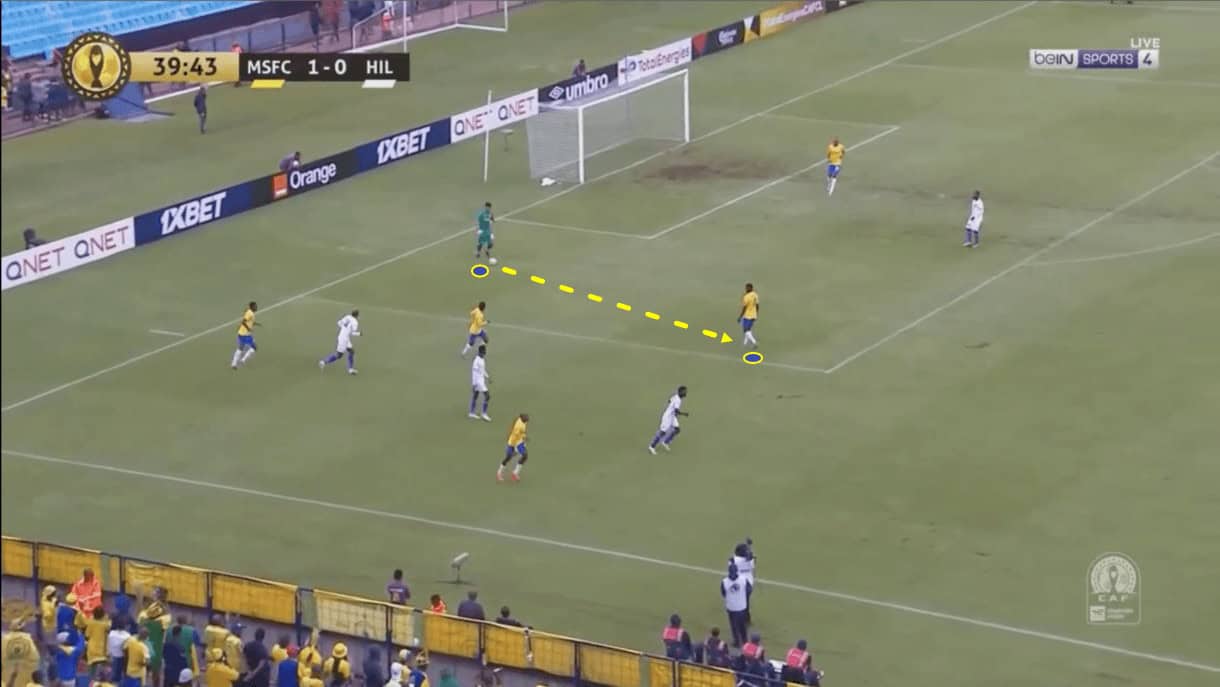
After receiving the ball, Williams is careful and takes his time before playing the next pass. This disrupts the team’s rhythm in possession a little bit but ensures the ball isn’t lost at a crucial moment due to a misplaced pass with the goal left open.
Williams has it engrained into him within this environment that he has a significant role to play in helping his team out of jams like this in possession. He’s not one who’s thinking first and foremost about ensuring the goal is protected in case the ball is lost, his first thought is how he can help prevent a deep turnover in the first place by giving his outfield teammates another option even if that comes at the expense of coverage in the goal.
This is a risk and will inevitably backfire at some point but Sundowns hope that with their team’s comfort and ability on the ball, including the goalkeeper, they’ll avail of the benefits of this strategy more than suffer from the consequences, with those benefits being that they can break the opposition’s press and continue moving upfield more often, thus creating more goalscoring opportunities.

From this same game here in figure 3, we see how Williams is very comfortable holding the ball and drawing a bit of pressure. As his unusually high involvement creates an extra man for Sundowns in possession than teams will typically have, it can create more deep overloads and free men for him to link up with, as the image above shows.
As Williams comes under pressure from the centre-forward, the ‘10’ behind him is left with a choice to make about whom to mark — Sundowns’ left central midfielder or right central midfielder. This central 2v1 overload is a dream for a team to generate in the build-up and Williams capitalises on the opportunity here, finding the free man in the next line and helping his team to progress through the centre.
So, we can clearly see how the South African side’s unshackled use of the goalkeeper helps the team to create numerical advantages further upfield as a by-product of the fact it creates an obvious extra man advantage deeper with the goalkeeper somewhat acting as a normal outfielder in the build-up.
Stepping up outside the box
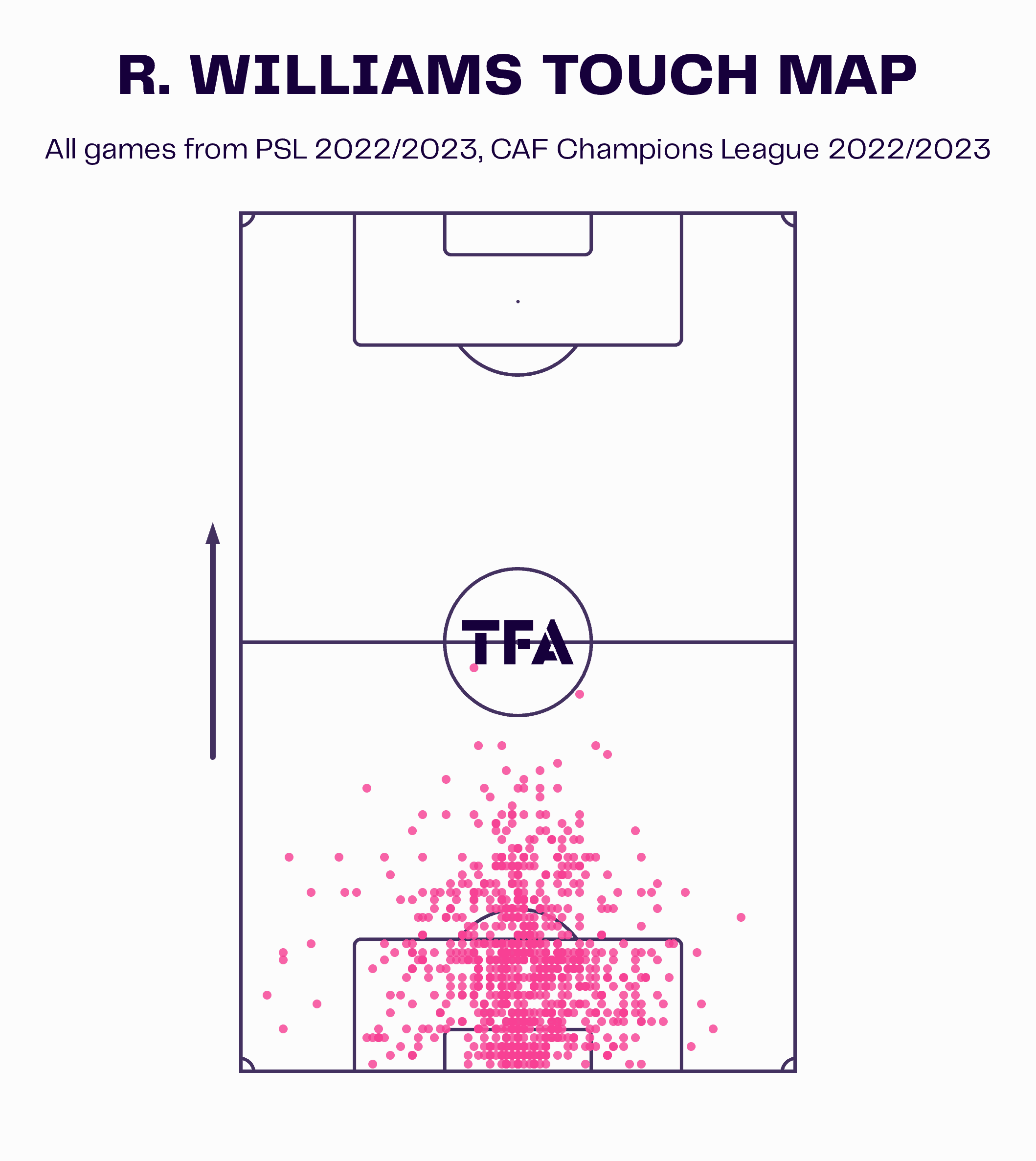
As his touch map for 2022/23 in figure 4 shows, Williams doesn’t just offer his team an extra man when looking to escape pressure from deep or progress beyond the opposition’s first line of defence, he also steps up into far more advanced areas and helps his team in ball progression, essentially acting as you might expect a third centre-back to act in this phase of play.
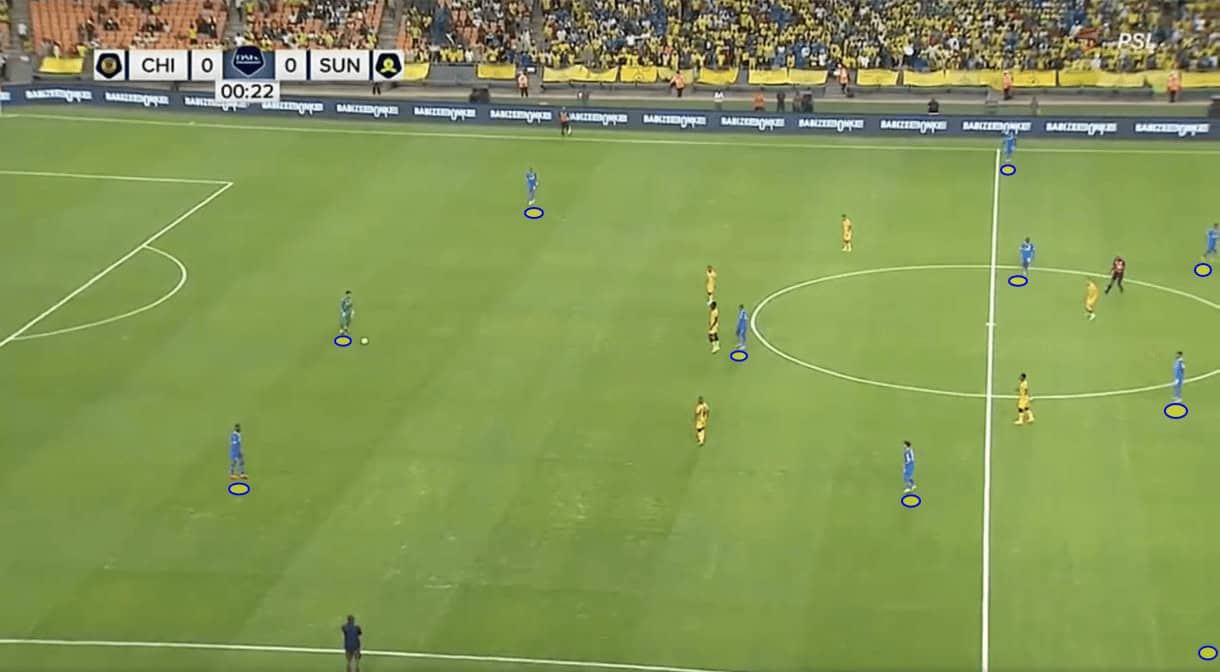
Figure 5 presents an example of Williams stepping up into this more advanced position and helping his team by providing a +1 advantage as they move into the progression phase.
By moving into this position, Williams allows his team’s centre-backs to shift higher and wider, which then, in turn, affords the same luxury to the full-backs who can get very high and wide, putting plenty of pressure on the opposition’s backline who need to cope with the extra numerical pressure as a result.

As play moves on into figure 6, we see how Williams actually makes use of the advanced right-back who’s found freedom on the right wing — sending the long ball his way and creating a clear opportunity for his team to move into the final third.
This freedom for the right-back was created by the goalkeeper, firstly, moving up and allowing him the freedom to push so high and, secondly, playing such a well-weighted ball over the top and out to the wing.

We often see Williams position himself about halfway between the goal and where the centre-backs have pitched themselves up, essentially offering an in-possession safety net for the centre-backs to fall on if pressure mounts too much or to use if they want to try and draw the opposition a bit higher with their press, effectively looking at the goalkeeper as a way of baiting them out and potentially creating space to exploit further upfield.
Within this Sundowns system, the ‘keeper can be a bit of a ‘quarter-back’ at times. This sounds a bit crazy, considering that even just using centre-backs in this manner has only become prominent relatively recently but I do think it’s a fair assessment to say there’s a decent amount of creative responsibility within the ‘keeper’s role in this system. That’s not to say he’s a playmaker at all, but when the ‘keeper receives the ball as we observe in figure 7, players further upfield will be aware of his passing range and look to make runs for him to see and exploit, as we see when the play progresses into figure 8.
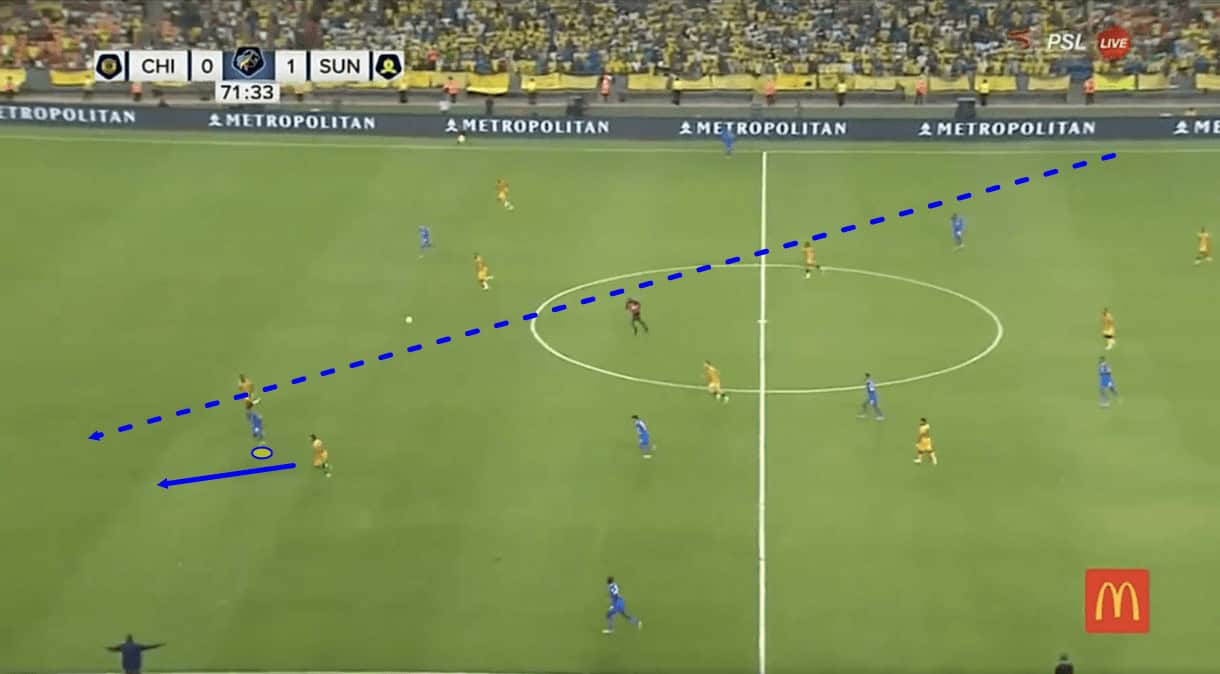
After receiving the ball behind the centre-backs, Williams had time and space to get his head up and pick out this long ball over the top into the striker’s path. The forward can chase the ball in behind and help his team gain a lot of territory entering the final third. This is more than just hit and hope, this is an exhibit of the ‘keeper’s impressive, precise passing range and how it can be a serious weapon for The Brazilians to use to put his team in an advantageous position when, perhaps, the opposition don’t expect it to come.
There is still some ‘element of surprise’ in Sundowns’ use of the ‘keeper which helps to take advantage of opportunities like this one when they appear.
Other examples of this concept from around the world
Our final section of this scout report looks at a couple of other examples of goalkeepers who perform in this manner from around the world. Firstly, we’ll go from South Africa to Germany and stop off at Volksparkstadion to take a look at 2. Bundesliga side Hamburger SV, and their goalkeeper, Daniel Heuer Fernandes.
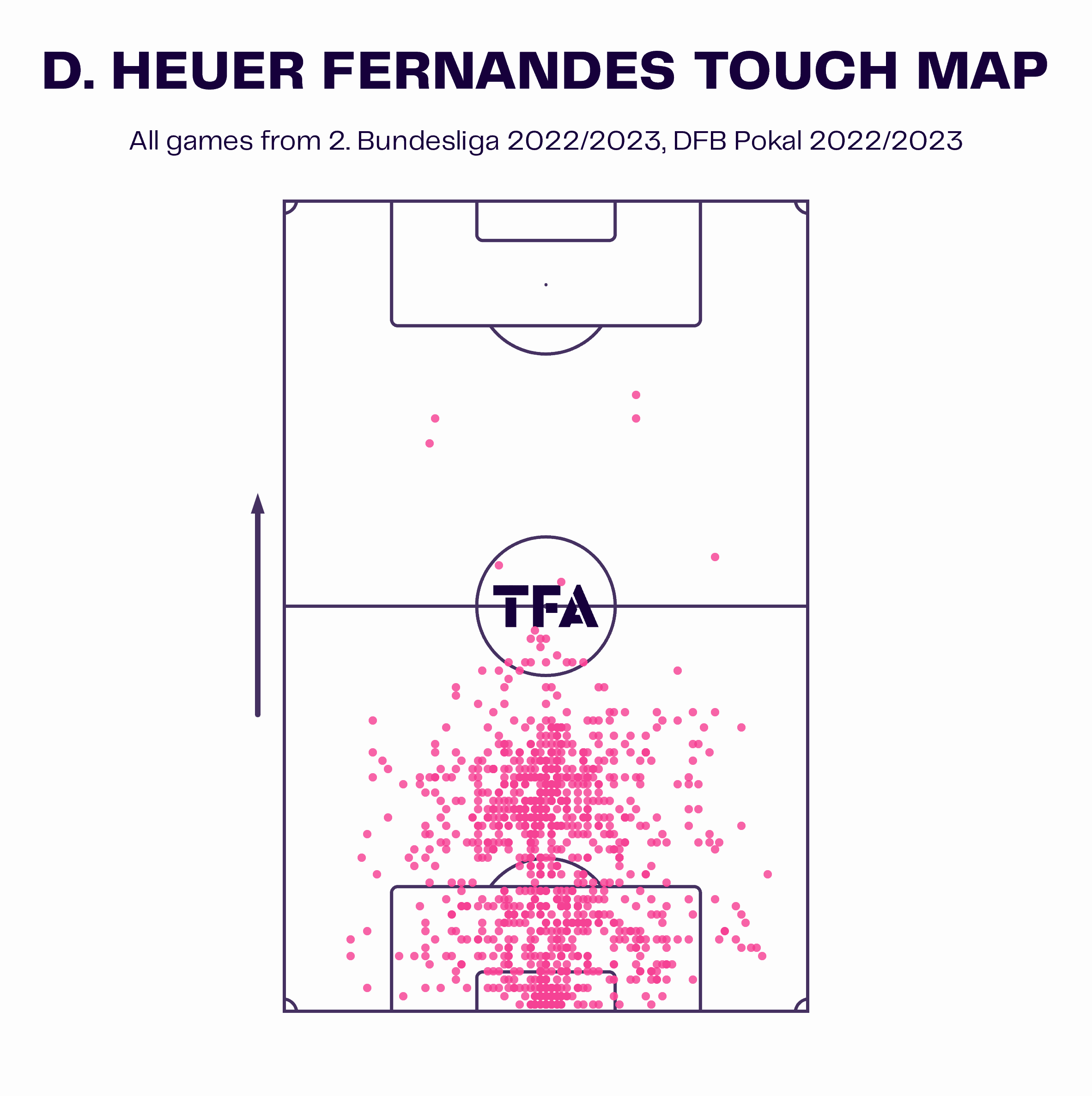
Similar to Williams, Fernandes has a very adventurous touch map for a goalkeeper. He’s frequently found outside of the goalkeeper’s traditional comfort zone and where he really shines as an asset for HSV is how he helps the team’s ball progression.
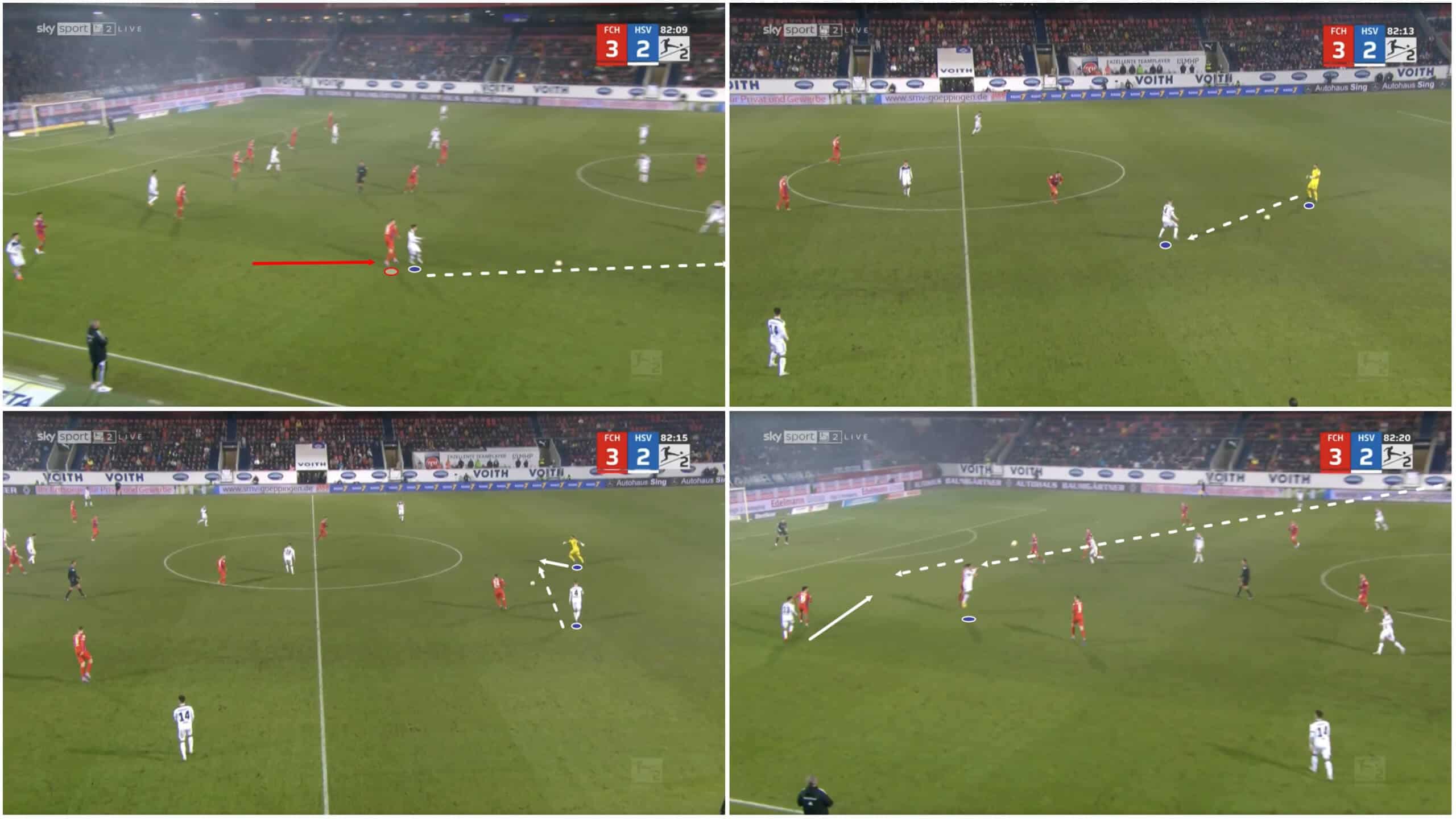
As figure 10 demonstrates, Fernandes can help his team similarly to Williams by providing a safety net for the team to fall back on in possession if they need to — an option we see HSV’s left-back taking up in the top-left quadrant above.
After receiving, the ‘keeper plays the ball to the left centre-back before moving further to the right and up into a slightly more advanced position where you might typically expect to find the right centre-back. With the goalkeeper performing this role instead, it allows HSV’s centre-backs and full-backs to settle in further upfield, similar to their counterparts at Mamelodi Sundowns; this can help generate more numerical advantages.
As play moves on into the bottom-right quadrant above, we see how the goalkeeper’s long ball, in the end, meets an attacking teammate’s head, and that player can then knock the ball on into the path of a runner moving in behind. So we can see some of the similar ‘quarter-back’ aspects of this role present with the German side as we saw with the South Africans earlier.

We have a greater view of the whole pitch when HSV’s ‘keeper has moved up into this right centre-back position in figure 11. The ‘keeper’s aggressive involvement helps generate a 3v2 versus the opposition’s first line of defence which allows the ‘keeper to break that first line with a progressive pass between the forwards and into midfield.

From there, the receiver in midfield has plenty of space to turn, get his head up and send a through ball out to the overlapping left-back who’s enjoying lots of space out wide; he was helped to pick up this position by the ‘keeper advancing out into the backline in the first place and ended up getting onto the end of a very nice through ball entering the final third after the ‘keeper found a free man in midfield for the team to push forward through.
Again, here, we see plenty of benefits to this strategy for the team in possession; it essentially creates a +1 outfield advantage at all times which can be very tricky for the defending team to cope with.
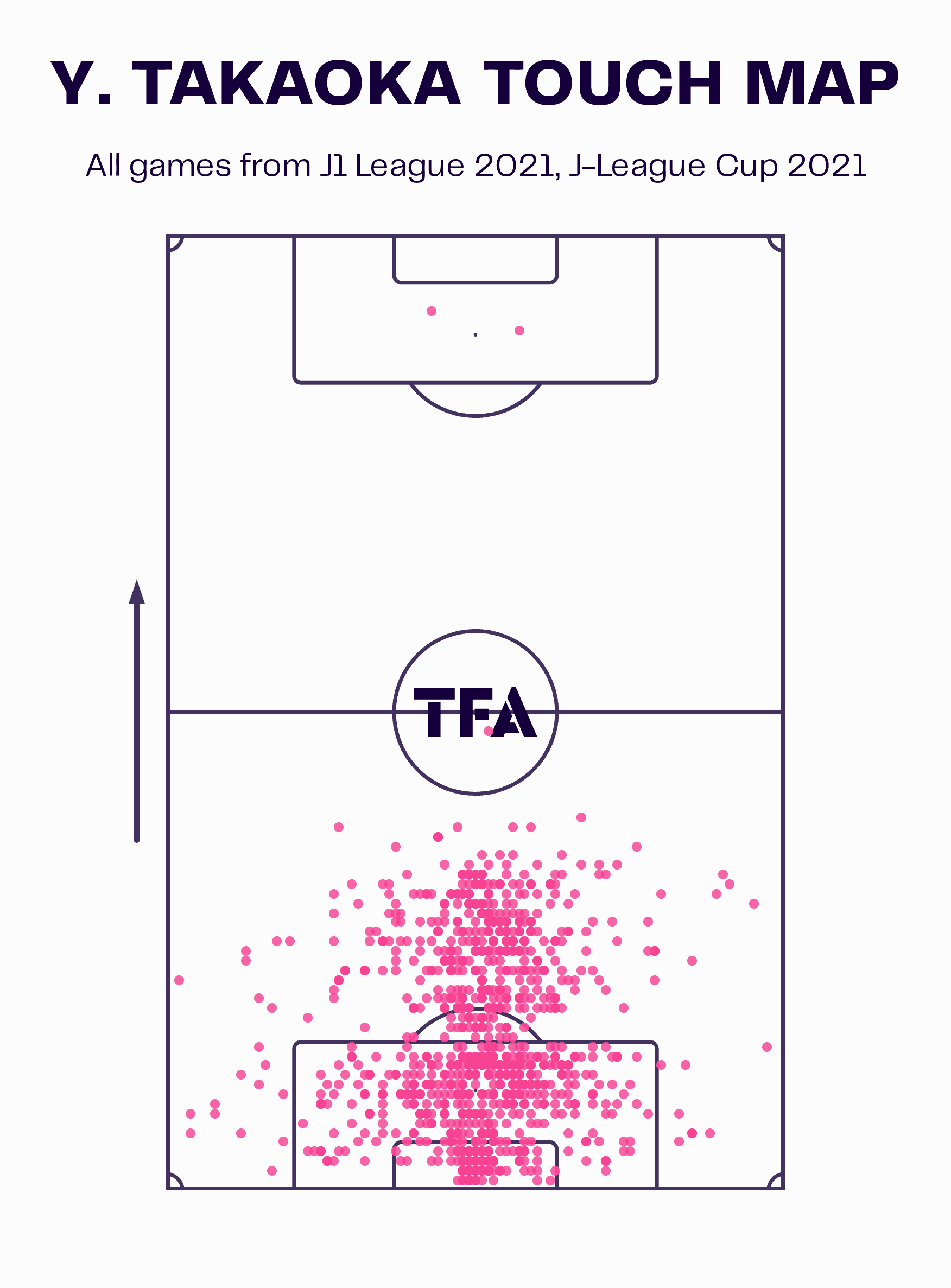
Lastly, we’ll go from Germany to Japan, making a beeline for Nissan Stadium where we’ll find Yokohama F. Marinos, the former club of current Celtic boss Ange Postecoglu and currently under the guidance of Kevin Muscat, formerly of Celtic’s arch-rivals Rangers, EFL Championship side Millwall (where he became an infamous foe of Neil Warnock’s favourite son, Paddy Kenny — if you know, you know) and EPL side Wolverhampton Wanderers, to name a few.
Marinos won one of Asia’s toughest leagues — Japan’s J1 League — last season, and goalkeeper Yohei Takaoka, who’s set to move to MLS side Vancouver Whitecaps, played a critical role in that title success.
As we see from figure 13, the 26-year-old ‘keeper spent a lot of time outside of his box, similar to the previous two goalkeepers we’ve looked at in this scout report.
Again, just like the other two goalkeepers we’ve looked at here, he provided an option for the defenders to go back to if necessary without losing too much ground as you would by going back to a goalkeeper acting in a more traditional, conservative manner.
However, where Takaoka really stands out, for us, is in his ability to help the team when under pressure in deeper areas, via his willingness to make himself available for his teammates and get on the ball, providing a good passing option to his teammates.
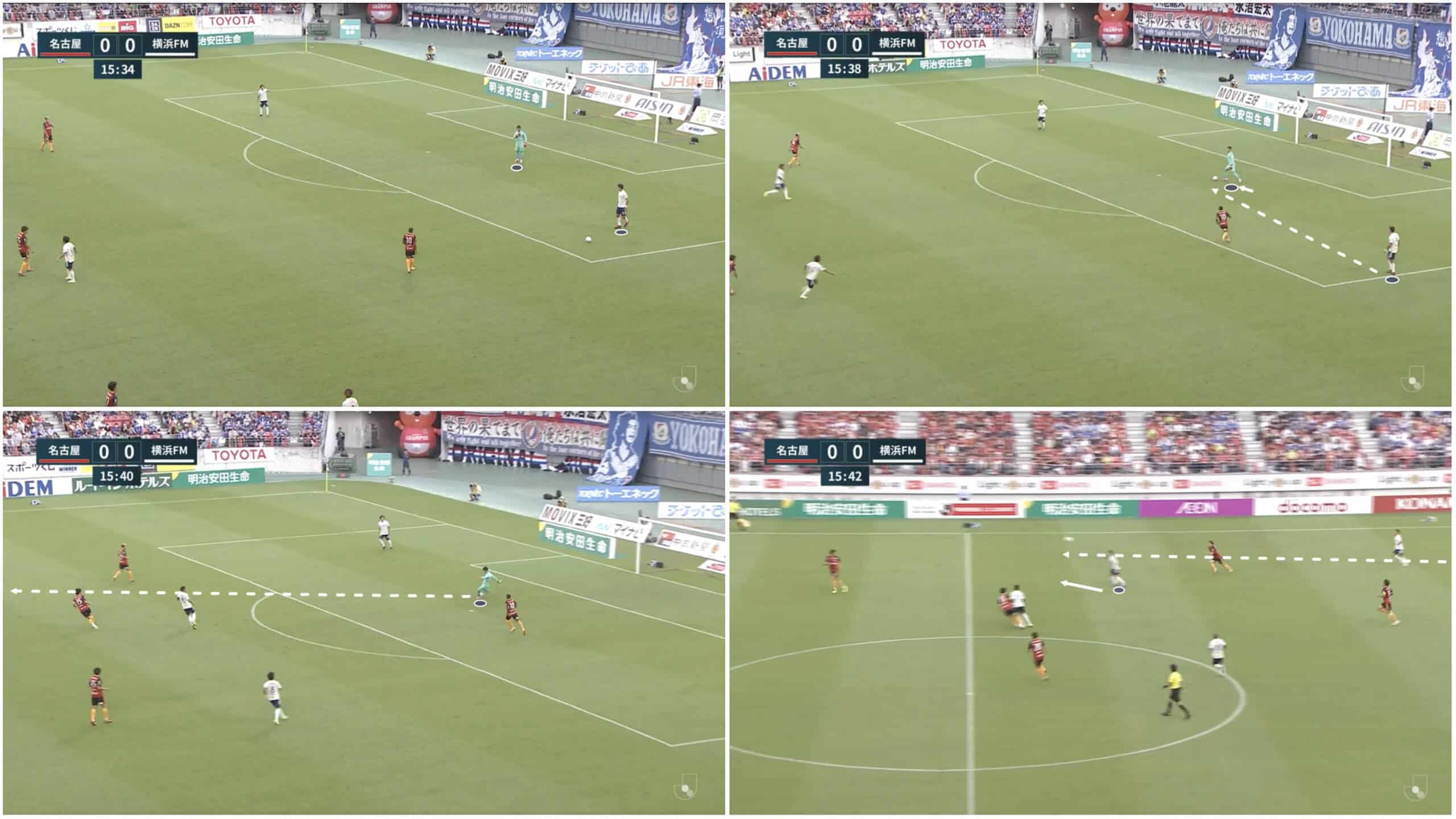
We see an example of this in figure 14, where Takaoka initially demands the ball while scanning the field ahead of him. After the pass is played to him, he receives very well, opening up his body to the right side of the pitch before splitting the opposition open with a line-splitting ball played towards a free man in midfield, who can get on the ball and drive the team forward from there after receiving.
Takaoka was crucial to Marinos getting past the press and into a more advantageous position here.
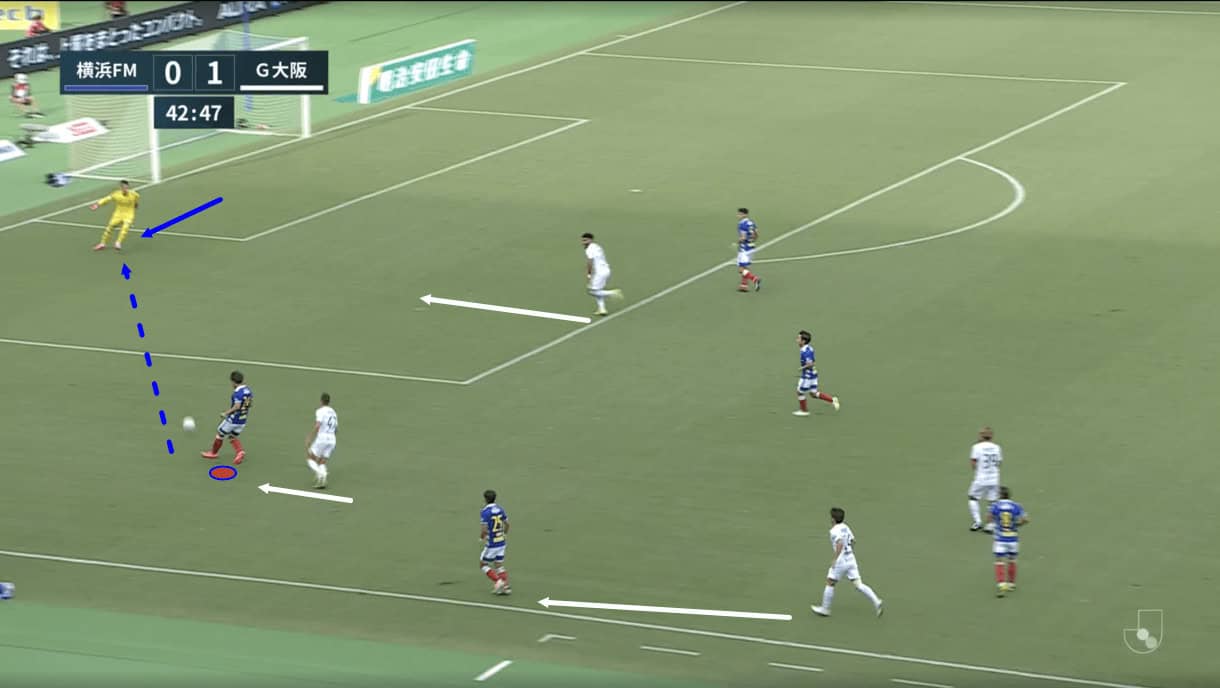
Another example in figure 15 shows Takaoka leaving his six-yard box and making an easier angle for the defender to find the goalkeeper, who can then help Marinos play past the aggressive press that’s put them in trouble, forcing them back to the ‘keeper.
Similar to Williams in figure 1, by moving out and providing a passing option here, Takaoka helps his team to retain possession for longer and play past the press when doing so appeared difficult for the defenders alone.
These examples show why we feel what Takoaka offers when the team is under pressure deep is his most valuable asset. He’s great at offering good passing angles to his teammate, he actively wants and seeks the ball and scans well to be aware of his surroundings and his next move after receiving, all of which adds to his air of composure and confidence.
Conclusion
Of course, the risks of playing like this are very important to be aware of, and this kind of strategy does require good on-the-ball ability from the ‘keeper. However, we could be seeing a glimpse of the future of the goalkeeper position (in possession phases) in these teams.
Personally, I’ve sometimes been annoyed by seeing inefficient use of the goalkeeper in possession. You might see a centre-back positioned just in front of the ‘keeper, and the team simply ignoring the ‘keeper in possession. But if a team can use the goalkeeper as they’d use that centre-back, and then commit more numbers upfield generating more overloads in advanced positions, it can actually help them to progress through the opposition more safely and with greater ease.
We see clear benefits to this strategy now, as only a select number of teams use their goalkeeper so freely. But will it become more and more normalised over the coming years?




Comments